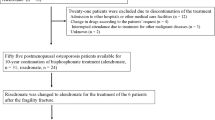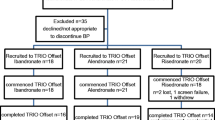Abstract
Bisphosphonates are known to be potent inhibitors of osteoclast activity and their only clinically relevant effect in the short-term is the selective inhibition of bone resorption. The purpose of this study was to compare the response to the intravenous administration of two bisphosphonates, clodronate and alendronate, of several biochemical markers of bone resorption, including tartrate-resistant acid phosphatase (TRAP) and cross-linked carboxyterminal telopeptide of collagen I (ICTP) in serum and hydroxyproline (OHP), free pyridinium cross-links (Pyr), and crosslinked N-telopeptides of collagen I (NTx) in urine. The study was carried out on 11 osteoporotic and 12 Pagetic subjects of both sexes, treated with clodronate (600 mg/day for 2 days) or alendronate (5 mg/day for 2 days), and monitored for 28 days after bisphosphonate administration. All the urinary markers of bone resorption showed a prompt decline after bisphosphonates, with maximum reductions after 7–14 days: Pyr decreased by 43%±9% and 42%±22% (mean ± SD), respectively in osteoporotic and pagetic subjects, OHP by 51%±14% and 51%±20%, and NTx by 55%±15% and 65%±26%. In the osteoporotic group, the urinary markers began to increase again at 30 days, though still remaining well below the basal level, whereas in the pagetic group, the excretion of all markers remained depressed until the end of the observation period. The reduction of NTx was significantly greater than that of Pyr and OHP in pagetic patients (P<0.05) and tended to be greater than that of Pyr in osteoporotic patients (p=0.07). Serum levels of TRAP decreased slightly, with a maximum reduction after 7 days of 16%±22% and 21%±11% in osteoporotic and pagetic subjects, respectively. Serum ICTP levels showed a slow and limited decrease, with minimal values after 14 days in pagetic subjects (-9%±21%; p=NS) and 30 days in osteoporotic patients (13%±4%; P<0.05). The cumulative changes of all urinary markers, expressed as area under the curve, were significantly greater than those observed for serum markers (P<0.01). In conclusion, these results indicate that the new markers of bone resorption differ in their capacity to reflect the acute inhibition of bone resorption following the I.V. administration of bisphosphonates. The use of bisphosphonates may be a useful means to test new markers of bone resorption.
Similar content being viewed by others
References
Delmas PD (1993) Biochemical markers of bone turnover. I: theoretical considerations and clinical use in osteoporosis. Am J Med 95:11S-16S
Riis BJ (1993) Biochemical markers of bone turnover. II: diagnosis, prophylaxis, and treatment of osteoporosis. Am J Med 95:17S-21S
Uebelhart D, Schlemmer A, Johansen JS, Gineyts E, Christiansen C, Delmas PD (1991) Effect of menopause and hormone replacement therapy on the urinary excretion of pyridinium crosslinks. J Clin Endocrinol Metab 72:367–373
Delmas PD, Schlemmer A, Gineyts E, Riis B, Christiansen C (1991) Urinary excretion of pyridinoline crosslinks correlates with bone turnover measured on iliac crest biopsy in patients with vertebral osteoporosis. J Bone Miner Res 6:639–644
Robins SP, Black D, Paterson CR, Reid DM, Duncan A, Seibel MJ (1991) Evaluation of urinary hydroxypyridinium crosslink measurements as resorption markers in metabolic bone diseases. Eur J Clin Invest 21:310–315
Moro L, Modricky C, Rovis L, de Bernard B (1988) Determination of galactosyl hydroxylysine in urine as a means for the identification of osteoporotic women. Bone Miner 3:271–276
Moro L, Pozzi Mucelli RS, Gazzarrini C, Modricky C, Marotti F, de Bernard B (1988) Urinary beta-1-galactosyl-0-hydroxylysine (GH) as a marker of collagen turnover of bone. Calcif Tissue Int 42:87–90
Hanson DA, Weis MA, Bollen AM, Maslan SL, Singer FR, Eyre DR (1992) A specific immunoassay for monitoring human bone resorption: quantitation of type I collagen cross-linked N-telopeptides in urine. J Bone Miner Res 7:1251–1258
Risteli J, Elomaa I, Niemi S, Novamo A, Risteli L (1993) Radioimmunoassay for the pyridinoline cross-linked carboxyterminal telopeptide of type I collagen: a new serum marker of bone collagen degradation. Clin Chem 39:635–640
Lau KH, Onishi T, Wergedal JE, Singer FR, Baylink DJ (1987) Characterization and assay of tartrate-resistant acid phosphatase activity in serum: potential use to assess bone resorption. Clin Chem 33:458–462
Fleisch H (1991) Bisphosphonates. Pharmacology and use in the treatment of tumour-induced hypercalcaemic and metastatic bone disease. Drugs 42:919–944
Pedrazzoni M, Palummeri E, Ciotti G, Davoli L, Pioli G, Girasole G, Passeri M (1989) Short-term effects on bone and mineral metabolism of 4-amino-1-hydroxybutylidene-1, 1-diphosphonate (ABDP) in Paget's disease of bone. Bone Miner 7:301–307
Watts RA, Skingle SJ, Bhambhani MM, Pountain G, Crisp AJ (1993) Treatment of Paget's disease of bone with single dose intravenous pamidronate. Ann Rheum Dis 52:616–618
O'Doherty DP, Bickerstaff DR, McCloskey EV, Hamdy NA, Beneton MN, Harris S, Mian M, Kanis JA (1990) Treatment of Paget's disease of bone with aminohydroxybutylidene bisphosphonate. J Bone Miner Res 5:483–491
O'Rourke NP, McCloskey EV, Vasikaran S, Eyres K, Fern D, Kanis JA (1993) Effective treatment of malignant hypercalcaemia with a single intravenous infusion of clodronate. Br J Cancer 67:560–563
Jansson S, Tisell LE, Lindstedt G, Lundberg PA (1991) Disodium pamidronate in the preoperative treatment of hypercalcemia in patients with primary hyperparathyroidism. Surgery 110:480–486
Papapoulos SE (1993) The role of bisphosphonates in the prevention and treatment of osteoporosis. Am J Med 95:48S-52S
Verch RL, Wallach S, Peabody RA (1979) Automated analysis of hydroxyproline with elimination of non-specific reacting substances. Clin Chim Acta 96:125–130
Seyedin SM, Kung VT, Daniloff YN, Hesley RP, Gomez B, Nielsen LA, Rosen HN, Zuk RF (1993) Immunoassay for urinary pyridinoline: the new marker of bone resorption. J Bone Miner Res 8:635–641
Siegel S, Castellan NJ (1988) Nonparametric statistics for behavioral sciences. McGraw-Hill, Inc., New York
Matthews JN, Altman DG, Campbell MJ, Royston P (1990) Analysis of serial measurements in medical research. BMJ 300:230–235
Adami S, Bhalla AK, Dorizzi R, Montesanti F, Rosini S, Salvagno G, Lo Cascio V (1987) The acute-phase response after bisphosphonate administration. Calcif Tissue Int 41:326–331
Kanis JA, McCloskey EV, Sirtori P, Khan S, Fern D, Eyres K, Aaron J, Beneton MN (1993) Rationale for the use of clodronate in osteoporosis. Osteoporos Int 3 (suppl 2) S23-S28
Netelenbos JC, van Ginkel FC, Lips P, Leeuwenkamp OR, Barto R, van der Vijgh WJ, van der Wiel H, Hackeng WH (1991) Effect of a single infusion of aminohydroxypropylidene on calcium and bone metabolism in healthy volunteers monitored during 2 months. J Clin Endocrinol Metab 72:223–228
Delmas PD, Gineyts E, Bertholin A, Garnero P, Marchand F (1993) Immunoassay of pyridinoline crosslink excretion in normal adults and in Paget's disease. J Bone Miner Res 8:643–648
Garnero P, Gineyts E, Arbault P, Christiansen C, Delmas PD (1994) Different effects of bisphosphonate and estrogen therapy on the excretion of free and peptide-bound crosslinks. J Bone Miner Res 9 (suppl 1):S154
Adami S, Rossini M, Zamberlan N, Bertoldo F, Gatti D, Braga V (1994) Long-term effects in postmenopausal osteoporosis of a treatment course with alendronate. Bone Miner 25:S72
Garnero P, Shih WJ, Gineyts E, Karpf DB, Delmas PD (1994) Assessment of 8 markers of bone turnover in elderly osteoporotic women treated with alendronate (ALN). Bone Miner 25:S72
Uebelhart D, Gineyts E, Chapuy MC, Delmas PD (1990) Urinary excretion of pyridinium crosslinks: a new marker of bone resorption in metabolic bone disease. Bone Miner 8:87–96
Hamdy NA, Papapoulos SE, Colwell A, Eastell R, Russell RG (1993) Urinary collagen crosslink excretion: a better index of bone resorption than hydroxyproline in Paget's disease of bone? Bone Miner 22:1–8
Rosen HN, Dresner Pollak R, Moses AC, Rosenblatt M, Zeind AJ, Clemens JD, Greenspan SL (1994) Specificity of urinary excretion of cross-linked N-telopeptides of type I collagen as a marker of bone turnover. Calcif Tissue Int 54:26–29
Harris ST, Gertz BJ, Genant HK, Eyre DR, Survill TT, Ventura JN, DeBrock J, Ricerca E, Chesnut CH (1993) The effect of short-term treatment with alendronate on vertebral density and biochemical markers of bone remodeling in early postmenopausal women. J Clin Endocrinol Metab 76:1399–1406
Bell NH, Hollis BW, Shary JR, Eyre DR, Eastell R, Colwell A, Russell RGG (1994) Diclofenac sodium inhibits bone resorption in postmenopausal women. Am J Med 96:349–353
Marshall MJ, Holt I, Davie MW (1993) Osteoclast recruitment in mice is stimulated by (3-amino-1-hydroxypropylidene)-1, 1-bisphosphonate. Calcif Tissue Int 52:21–25
Eriksen EF, Charles P, Melsen F, Mosekilde L, Risteli L, Risteli J (1993) Serum markers of type I collagen formation and degradation in metabolic bone disease: correlation with bone histomorphometry. J Bone Miner Res 8:127–132
Charles P, Mosekilde L, Risteli L, Risteli J, Eriksen EF (1994) Assessment of bone remodeling using biochemical indicators of type I collagen synthesis and degradation: relation to calcium kinetics. Bone Miner 24:81–94
Hassager C, Jensen LT, Risteli L, Risteli J, Christiansen C (1993) Serum carboxy-terminal pyridinoline crosslinked telopeptide of type I collagen (sICTP) as a marker of bone metabolism: the effect of menopause, hormone replacement therapy, and anabolic steroid. J Bone Miner Res 8 (suppl 1):S249
Eyres KS, McCloskey EV, Fern D, O'Rourke N, Vaiskaran S, Risteli J, Risteli I, Kanis JA (1992) Serum type 1 collagen carboxyterminal crosslinked telopeptide (S-1CTP) in Paget's disease of bone and the effect treatment with bisphosphonates. Bone Miner 17:S29
Hassager C, Jensen LT, Podenphant J, Thomsen K, Christiansen C (1994) The carboxy-terminal pyridinoline cross-linked telopeptide of type I collagen in serum as a marker of bone resorption: the effect of nandrolone decanoate and hormone replacement therapy. Calcif Tissue Int 54:30–33
Filipponi P, Pedetti M, Beghe F, Giovagnini B, Mian M, Cristallini S (1994) Effects of two different bisphosphonates on Paget's disease of bone: ICTP assessed. Bone 15:261–267
Author information
Authors and Affiliations
Rights and permissions
About this article
Cite this article
Pedrazzoni, M., Alfano, F.S., Gatti, C. et al. Acute effects of bisphosphonates on new and traditional markers of bone resorption. Calcif Tissue Int 57, 25–29 (1995). https://doi.org/10.1007/BF00298992
Received:
Accepted:
Issue Date:
DOI: https://doi.org/10.1007/BF00298992




